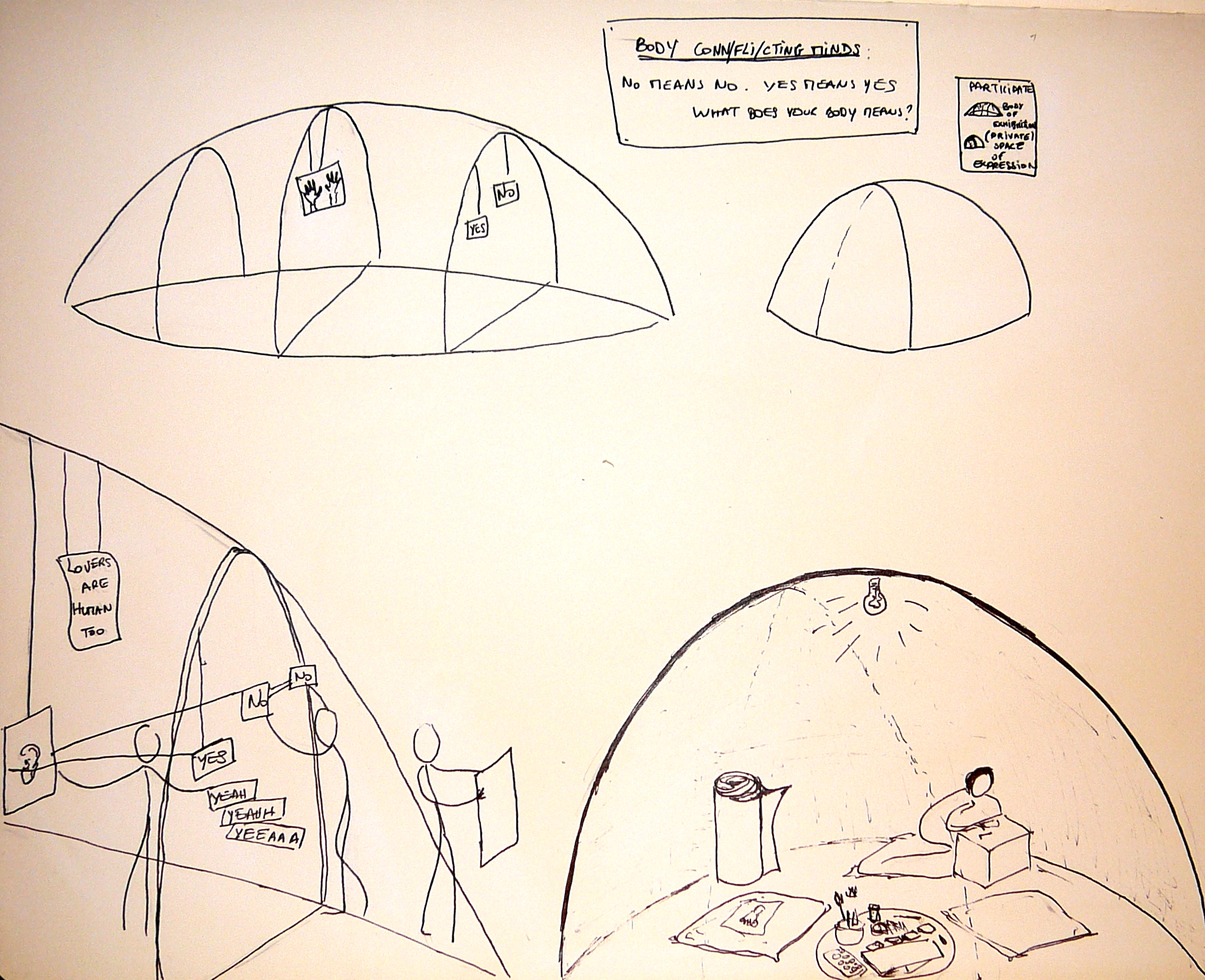BodyConnFliCtingMinds
by goldjian

This work has been commented by 1 curator(s). Read the comments
Title
BodyConnFliCtingMinds
Headline
No means no. Yes means yes. What does your body mean ?
Concept author(s)
Goldenberg Anne
Concept author year(s) of birth
1979
Concept author(s) contribution
As mentionned in the file in attachement, I work on the previous installations with Rut Jesus, an other researcher involved in the comprehension of wikis and wikiaffiliated structures. I now have a PhD in communication and sociology during wich I studied negotiations of contributions in public wikis. I'm a wiki and free software researcher and practitioner, and I directed the Wikigraphe project, co-organized the RococoCamp / RecentchangesCamp who was held in Montreal 2006 and 2010. I teach free software and wiki principles to several classes, research groups, community groups and to unions. I'm also specialized in the organization of OpenSpace. I set up a first version of Our Coll/nn/ective Minds at the Artivistic Festival in October 2009, Montreal, 3 other versions with Rut Jesus in Bangalore in January 2010 and in Gdansk, Poland in June 2010. BodyConn/Fli/cting is an evolved version of those previous works that I will set up alone.
Concept author(s) Country
Canada
Friendly Competition
Love Conflict Imagination (2010-2011)
Competition category
Mobilization
Competition field
nonacademic
Competition subfield
artist
Subfield description
Participatory installation
Check out the Love Conflict Imagination 2010-2011 outlines of Memefest Friendly competition.
Description of idea
Describe your idea and concept of your work in relation to the festival outlines:
"Body Conn/fli/cting Mind" is a participatory installation which will bring the public to explore and expose the potential connections and conflicts that lie between voice and body language in intimate relations. They will be asked to reflect upon the body connecting or conflicting the mind. When "No means no. Yes means yes" refers to well known affirmation about physical needs, "What does your body mean ?" questions the assumption that body language is easily listened to, understood or understandable. The installation will consist in two spaces: * A spheric intimate space that could eventually be closed for private forms of expression. It will be furnished with a few cushions and equipped with material (paint, pens, brushes, plasticine, paper, strings and a tape recorder). * An oblong open structure, visible and usable from the outside, whose walls will constitute a collective space of exhibition to hang and connect written, painted and modeled concepts about the subject. In the intimate space, the participants will be asked to produce text, shapes images in the intimate space and to dispose them in the open structure. Large rolls of paper and painting would allow among other ways of expression, some body print. The tape recorder content will be used for on-line exhibition of the production of the installation.
What kind of communication approach do you use?
I use participatory installations as a way to have the public expressing and discussing the subject that I choose. Having studied the politics of communication devices in my Phd (wikis in particular), I'm putting lot of attention on how the description and the settings will lead the public to participate in a certain way. In "Bodies Conn/fli/cting Minds", the participants (that we assume to be composed of thinkers, artists, activists and feminists) will be asked to reflect upon the misunderstandings and complicities, consensus and violation which emerge when communication is torn between body and voice.
What are in your opinion concrete benefits to the society because of your communication?
When bodies meet beautifully in silence or with unintelligible sounds, movements are understood as a language. But lack of verbal communication is also the source of controversies. Even though feminism have built some first steps toward more consensual intimate relations, cultural, gendered, political or physical contexts as well as lack of communication tools makes it difficult to relate carefully to ours and the other bodies. This installation is aimed at opening a space of expression and discussion about the following questions. How do bodies (dis)connect with minds, how do we communicate with or misunderstand each other when language becomes embodied, when the body is said to be talking, when we guess what the other mean, when we don't speak but only move in silence ? How do you take care of this sensitive connection? How do we eventually rebuild it when lost ? We want the participants to think about and share their own experiences with this issue. The production of the installation will be carefully documented, for diffusion on the web, but also for eventual adjustment in regard with possible reuse in other contexts.
What did you personally learn from creating your submitted work?
I wanted to articulate the relation between power and love since a long time, but didn't know how to make the connection. Having recently been involved in different discussions dealing with misunderstanding concerning sexual abuse and mutual consent and discourse and relation to the body, this adaption of the "Our Coll/nn/ective Minds" into "Body Conn/fli/cting Minds" helped me in a necessary exploration of the issue. I'm looking forward it's exploration in a participatory context.
Why is your work, GOOD communication WORK?
My installations are inspired by my studies of public wikis as well as participatory methodology in technical and pedagocical contect. The concept borrows from relational art with a political insight.
Communication is often mislead with diffusion and expression. As Julie Chateauvert (Les Délicates Attentions) phrases and teaches it "Communication is a shared responsibality" (2). It come from ourself toward a dialogue. When diffusion is a way of conceiving a knowledge to be spread toward an audience, expression refers to a free space of exploration and exposition of the self. Expression right is crucial in many places when only diffusion or controlled knowledge is allowed. It is a process of allowing an inner flow to take shape outside.
The intimate space settled in this installation is aimed at helping the participants to conceive an expression of it's own, or in small groups, separated from the public view. But expression become communication when there is an audience, and a meeting with other people expressing theirself. Therefore clarity and coherence become important. Communicating appeals a relation with at least two entities sharing knowledge or information. Bringing participants to share a common space of exhibition, asking them to make sense of their proposition in a conceptual and physical context will bring them to loudly or silently discuss their contribution with the other. Finally, the installation is an attempt to make the participant communicating about the subject, but also to embody its materiality. The unclosed tent is a metaphor of the head, when the public structure is a metaphor of the body. Moving from one to the other, thinking in a close space and meeting with the publicity of the body is a way to actively understand a process and discuss it's productions.
Where and how do you intent do implement your work?
The open space will constitute an ongoing and live exhibition of the participant expression of the subject. A photo and voice report will be put on-line on the following address http://ourcollnnectiveminds.blogspot.com/. Unless explicit mention by the participants, content will be placed under a free license (cc by sa). Extrovert, hesitating or shy participants are all welcome to join this public depiction of body and mind entanglements and (ex-) tensions within intimacy. The physical installation requires some space. Around 2 meters by 4 meters would be necessary but I could still adjust it with the local possibilities. For example, "Our Coll/nn/ective Minds" installation have been settled twice outdoors with great success too. Note that "Body Conn/fli/cting Minds" will possibly be produced in other festivals, such as the QueerRadical Week in Montreal.
(1) see and http://artivistic.org/en/node/303 and http://ourcollnnectiveminds.blogspot.com/ for more details, as well as the analysis done by Rut Jesus about the ourcollnnectiveminds installation in her Phd Thesis http://www.nbi.ku.dk/english/Calendar/activities_10/phd_defense_rut_jesus/ (2) http://www.nooslogos.org/content/formation-la-communication-une-responsabilit%C3%A9-partag%C3%A9e
Did your intervention had an effect on other Media. If yes, describe the effect? (Has other media reported on it- how? Were you able to change other media with your work- how?)
Curators Comments

Kevin Yuen-Kit Lo
This is a strong conceptual proposal that addresses the festival themes very well. I really appreciate the physical creation of dialogic spaces, in order to explore ideas of intimate dialogue and physical communication itself. In many ways, it is a very literal explosion of David Bohm's model of dialogue, while adding a creative/artistic element to the participants toolbox.
Having seen previous installations, I like how the aesthetic result often looks quite "primitive", which in some ways turns the very technology focussed notions of wikis on their head, creating a vision for multiple new models of dialogue building. The added consideration of a private intimate space in order to construct the messages is very interesting as well.
It's unfortunate that at this point, this is only a proposal. It would be very interesting to look at the documentation of the project, and how that could be treated. From previous examples, I find the quality of the documentation a little lacking. Though it is clear that the participant interaction is engaged and interesting, the end results of each installation are unclear. I wonder if there is a possibility of taking the participatory "communicative object" that is created and translating it into another medium or format. Could it be brought back into a digital wiki structure, or programmed to become something actionable? Could the documentation itself provide other forms of knowledge and experience?
